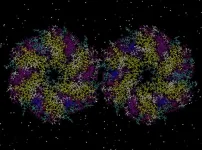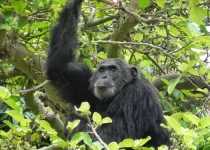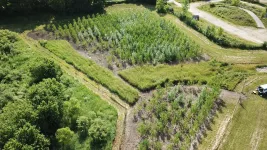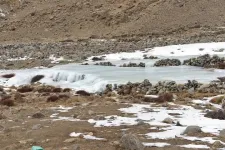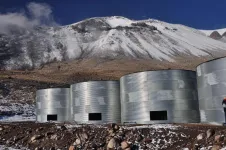(Press-News.org) Researchers at the University of Bath investigating how virtual reality (VR) can help improve balance believe this technology could be a valuable tool in the prevention of falls.
As people grow older, losing balance and falling becomes more common, which increases the risk of injury and affects the person's independence.
Falls are the leading cause of non-fatal injuries in over 65-yearolds and account for over 4 million bed days per year in England alone, at an estimated cost of £2 billion.
Humans use three ways of keeping their balance: vision, proprioceptive (physical feedback from muscles and joints) and vestibular system (feedback from semi-circular canals in the ear). Of these, vision is the most important.
Traditional ways of assessing balance include patient surveys and physical tests such as using a treadmill or testing agility when performing specific movements or exercises.
However, the accuracy of these tests can be affected by age, sex and motivation, and the movements measured aren't necessarily reflective of real-life scenarios.
Therefore, several research studies have explored the use of VR to help assess balance and even help train users to improve their balance.
Dr Pooya Soltani, from the University of Bath, and Renato Andrade, from Clínica do Dragão, Espregueira-Mendes Sports Centre - FIFA Medical Centre of Excellence, Porto (Portugal), reviewed data from 19 separate studies to investigate the validity, reliability, safety, feasibility and efficacy of using head-mounted display systems for assessing and training balance in older adults.
Their results, published in the scientific journal Frontiers in Sports and Active Living, found that VR was effective in assessing balance and could be useful for fall prevention and for improving postural control and gait patterns.
They found these systems also have the capacity to differentiate healthy and balance-impaired individuals.
Dr Soltani, Studio Engineer at CAMERA, the University of Bath's motion capture research centre, said: "Traditional tests for measuring balance can be inaccurate and sometimes unsafe - for example if the patient is on a treadmill that stops suddenly.
"It may also be difficult to replicate real life situations in a lab. But using VR opens up a huge range of possible scenarios that are more natural and relevant to the real world.
"For example, patients could be asked to cross a busy street and these scenes can be adapted easily to help them gradually improve their balance and build up confidence in their movement.
"Alternatively, VR could be used more like a video game where patients navigate virtually through a maze whilst doing additional cognitive tasks, like solving mathematical problems.
"VR gives us the flexibility to add disorientating effects or resize and remove elements, to test how well participants maintain their balance."
The researchers found that during VR versions of traditional balance tests, older adults generally acquired a cautious behaviour and took more time to complete the tasks. However, they tended to find them more enjoyable which could help encourage participants to stick to a rehabilitation programme.
Dr Soltani said: "Our review shows this technology has great potential, however there is a lot of work to do before it can be used widely in rehabilitation.
"We need to check parameters such as altering frame rate, find which scenarios are most effective, and also reduce the problems some users experience with motion sickness when using VR."
Whilst Covid19 has temporarily delayed plans to test the technology on volunteers, the researchers are now looking to recruit PhD students to define protocols and develop a robust system that can be tested by users later in the year.
INFORMATION:
RESEARCH TRIANGLE PARK, N.C. -- New Army-funded synthetic biology research manipulated micro-compartments in cells, potentially enabling bio-manufacturing advances for medicine, protective equipment and engineering applications.
Bad bacteria can survive in extremely hostile environments -- including inside the highly acidic human stomach--thanks to their ability to sequester toxins into tiny compartments.
In a new study, published in ACS Central Science, Northwestern University researchers controlled protein assembly and built these micro-compartments into different shapes ...
Boston - This year, more than 60,000 adults in the United States will be diagnosed with pancreatic cancer and, statistically, as few as 10 percent will survive five years after diagnosis, according to the American Cancer Society. Because pancreatic cancer is hidden deep within the body and often symptomless, it's frequently diagnosed after the disease has progressed too far for surgical intervention and/or has spread throughout the body. Research indicates that earlier detection of pancreatic tumors could quadruple survival rates; however, no validated and reliable tests for early detection of pancreatic cancer currently exist.
Now, researchers at the Cancer Research Institute at Beth Israel Deaconess Medical Center (BIDMC) have successfully created ...
Every day, the sun ejects large amounts of a hot particle soup known as plasma toward Earth where it can disrupt telecommunications satellites and damage electrical grids. Now, scientists at the U.S. Department of Energy's (DOE) Princeton Plasma Physics Laboratory (PPPL) and Princeton University's Department of Astrophysical Sciences have made a discovery that could lead to better predictions of this space weather and help safeguard sensitive infrastructure.
The discovery comes from a new computer model that predicts the behavior of the plasma in the region above the surface of the sun known as the solar corona. The model was originally inspired by a similar model that describes the behavior of the plasma that fuels fusion reactions in doughnut-shaped fusion facilities known ...
Although plants may look fairly inactive to casual observers, research into plant biology has shown that plants can send each other signals concerning threats in their local environments. These signals take the form of airborne chemicals, called volatile organic compounds (VOCs), released from one plant and detected by another, and plant biologists have found that a diverse class of chemicals called terpenoids play a major role as airborne danger signals.
Past studies have shown that soybean and lima bean plants both release terpenoid signals that activate defense-related genes in neighboring plants of the same species, and this chemically induced gene activation can help the plants protect themselves from ...
It's well established that infectious disease is the greatest threat to the endangered chimpanzees made famous by the field studies of Jane Goodall at Gombe National Park in Tanzania. Now, new research led by scientists at Emory University shows that nearly half of the fecal samples from wild chimpanzees contain bacteria that is resistant to a major class of antibiotics commonly used by people in the vicinity of the park.
The journal Pathogens published the findings.
"Our results suggest that antibiotic-resistant bacteria is actually spreading from people to non-human primates by making its way into the local watershed," says Thomas Gillespie, senior author ...
Rhinelander, Wis., April 28, 2021-- A research team from the USDA Forest Service and the University of Missouri has developed a new contaminant prioritization tool that has the potential to increase the effectiveness of environmental approaches to landfill clean-up.
Phytoremediation - an environmental approach in which trees and other plants are used to control leachate and treat polluted water and soil - hinges on matching the capability of different tree species with the types of contaminants present in soil and water. Identifying the worst contaminants ...
LAWRENCE -- College students across the country struggle with a vicious cycle: Test anxiety triggers poor sleep, which in turn reduces performance on the tests that caused the anxiety in the first place.
New research from the University of Kansas just published in the International Journal of Behavioral Medicine is shedding light on this biopsychosocial process that can lead to poor grades, withdrawal from classes and even students who drop out. Indeed, about 40% of freshman don't return to their universities for a second year in the United States.
"We were interested in finding out what predicted students' performance in statistics classes ...
MINNEAPOLIS/ST.PAUL (04/28/2021) -- In a recent discovery by University of Minnesota Medical School, researchers uncovered a new way to potentially target and treat late-stage colorectal cancer - a disease that kills more than 50,000 people each year in the United States. The team identified a novel mechanism by which colorectal cancer cells evade an anti-tumor immune response, which helped them develop an exosome-based therapeutic strategy to potentially treat the disease.
"Late-stage colorectal cancer patients face enormous challenges with current treatment options. Most of the time, the patient's immune system cannot efficiently fight against tumors, even with the ...
Seasonally occurring fields of aufeis (icing) constitute an important resource for the water supply of the local population in the Upper Indus Basin. However, little research has been done on them so far. Geographers at the South Asia Institute of Heidelberg University have now examined the spreading of aufeis and, for the first time, created a full inventory of these aufeis fields. The more than 3,700 accumulations of laminated ice are important for these high mountain areas between South and Central Asia, particularly with respect to hydrology and climatology.
In the semi-arid Himalaya regions of India and Pakistan, meltwater from snow and glaciers plays an essential role for irrigation in local agriculture and hydropower generation. In ...
LOS ALAMOS, N.M., April 28, 2021--Analysis of data from a lightning mapper and a small, hand-held radiation detector has unexpectedly shed light on what a gamma-ray burst from lightning might look like - by observing neutrons generated from soil by very large cosmic-ray showers. The work took place at the High Altitude Water Cherenkov (HAWC) Cosmic Ray Observatory in Mexico.
"This was an accidental discovery," said Greg Bowers, a scientist at Los Alamos National Laboratory and lead author of the study published in Geophysical Research Letters. "We set up this system to study terrestrial gamma-ray flashes - or gamma-ray bursts from lightning - that are ...
